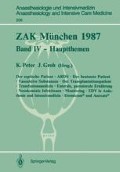Zusammenfassung
Regionale rückenmarksnahe Anästhesieverfahren wie Spinal- und Epiduralanästhesie gehen regelmäßig mit einer Blockade der präganglionären sympathischen Fasern einher. Beim flachliegenden normovolämen Patienten mit einer segmentalen Sympathikusblockade bis T5 werden nur geringe hämodynamische Veränderungen beobachtet, da durch Kompensationsmechanismen wie gesteigerter Sympathikotonus im ungeblockten Teil und der klinischen Prophylaxe mit Volumen meist ein Abfall des Blutdrucks verhindert werden kann.
Access this chapter
Tax calculation will be finalised at checkout
Purchases are for personal use only
Preview
Unable to display preview. Download preview PDF.
Literatur
Arndt JO et al (1985) Peridural anesthesia and the distribution of blood in supine humans. Anesthesiology 63:616–623
Boldt J et al (1986) Untersuchung zur isolierten Beeinflussung des Gefäßsystems durch verschiedene blutdrucksteigernde Medikamente (Akrinor, Etilefrin, Ephedrin, Norfenefrin, Amezinium) während der extrakorporalen Zirkulation beim Menschen. Anaesthesist 35:93–98
Butterworth JF et al (1986) Argumentation of venous return by adrenergic agonists during spinal anesthesia. Anesth Analg 65:612–6
Butterworth JF et al (1987) Effect of total spinal anesthesia on arterial and venous responses to dopamine and dobutamine. Anesth Analg 66:209–14
Engberg G, Wiklund L (1978) The use of ephedrine for prevention of arterial hypotension during epidural blockade. Acta Anaesth Scand 66:1–26
Imai Y et al (1978) Role of the peripheral vasculature in changes in venous return caused by isoproterenol, norepinephrine, and methoxamine in anesthetized dogs. Circ Res 43:553–561
Lundberg J et al (1987) Hemodynamic effects of dopamine during thoracic epidural analgesia in man. Anesthesiology 66:641–646
Müller H et al (1985) Hämodynamische Veränderungen nach der Bolusgabe verschiedener Vasopressiva zur Blutdruckstabilisierung bei Periduralanästhesie. Reg Anästh 8:43–49
Pflug AE, Halter JB (1981) Effect of spinal anesthesia on adrenergic tone and the neuroendocrine responses to surgical stress in humans. Anesthesiology 55:120–126
Ramanathan S et al (1983) Maternal and fetal effects of prophylactic hydration with crystalloids or colloids before epidural anesthesia. Anesth Analg 62:673–8
Ralston DH et al (1974) Effects of equipotent ephedrine, metaraminol, mephentermine, and methoxamine on uterine blood flow in the pregnant ewe. Anesthesiology 40:354–370
Shnider SM (1983) Vasopressors in obstetrics. Reg Anesth 8:74–80
Stanton-Hicks M et al (1987) Venoconstrictor agents mobilize blood from different sources and increase intrathoracic filling during epidural anesthesia in supine humans. 66:317–322
Stratmann D et al (1979) Klinische Verläufe von über 6000 Spinalanästhesien mit Bupiva- cain. Reg Anäst 2:49–56
Zimpfer M et al (1979) Aufhebung des Blutdruckabfalls bei Spinalanästhesie durch Dihydroergotamin (DHE). Reg Anäst 2:43–47
Editor information
Editors and Affiliations
Rights and permissions
Copyright information
© 1988 Springer-Verlag Berlin Heidelberg
About this paper
Cite this paper
Gerber, H. (1988). Vasoaktive Substanzen in der Regionalanästhesie. In: Peter, K., Groh, J. (eds) ZAK München 1987. Anaesthesiologie und Intensivmedizin / Anaesthesiology and Intensive Care Medicine, vol 206. Springer, Berlin, Heidelberg. https://doi.org/10.1007/978-3-642-73786-2_12
Download citation
DOI: https://doi.org/10.1007/978-3-642-73786-2_12
Publisher Name: Springer, Berlin, Heidelberg
Print ISBN: 978-3-540-19387-6
Online ISBN: 978-3-642-73786-2
eBook Packages: Springer Book Archive

